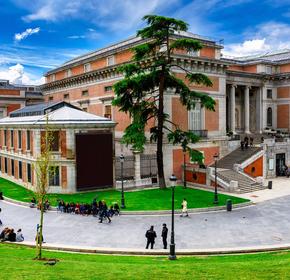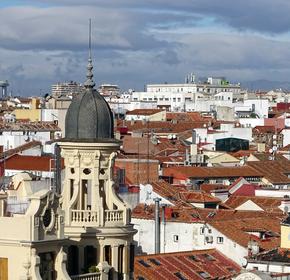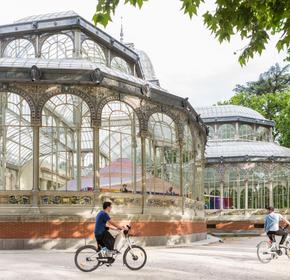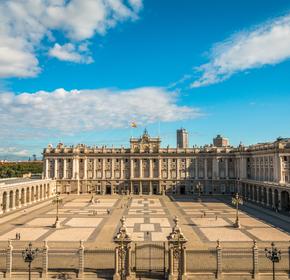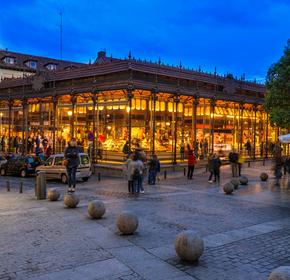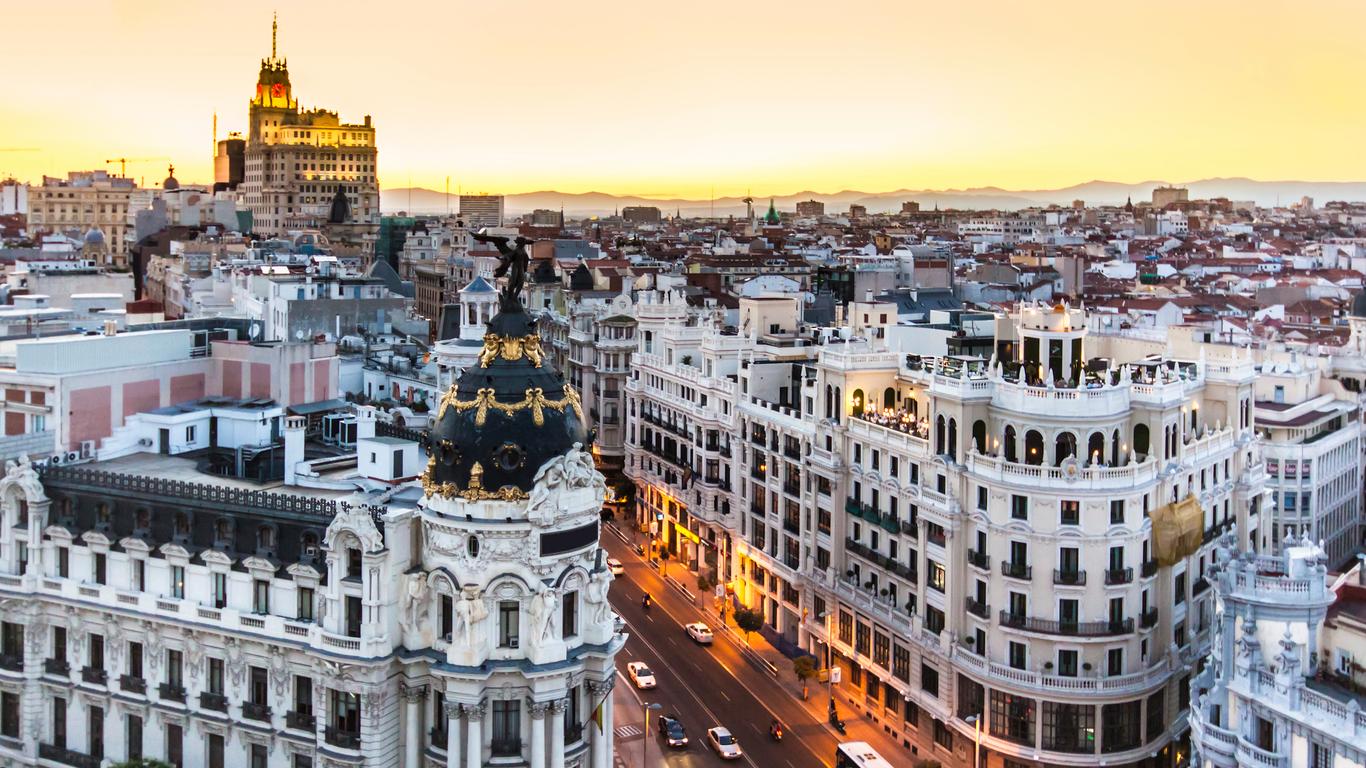
Madrid travel guide
Madrid Tourism | Madrid Guide
You're Going to Love Madrid
Spain's capital is an extraordinary city. Culturally dynamic, bursting with creativity and exuberance, it's a haven for clubbers, music fans, and art lovers. But it also has much to offer more relaxed vacationers.

From the endless masterpieces of the Museo del Prado to the shops of Gran Vía, Madrid is a city to explore at your own pace, and it's a city that visitors won't forget.
Sports fans can roar with the massive crowds at Real Madrid matches, while couples can walk arm in arm past the crystal palace and fountains in Buen Retiro Park. History lovers can learn about the Spanish Empire at the Royal Palace of Madrid, while everyone can tuck into patatas bravas, bowls of cocido Madrileño, and slices of satisfying Spanish omelette.
In short, if you want a city with fine food, great nightlife, museums, galleries, and a superb transportation network, Madrid is the destination to pick.
Top 5 Reasons to Visit Madrid
1. Fabulous Museums and Galleries
Madrid has one of the world's most extraordinary galleries: the Museo del Prado. From El Greco and Fra Angelico to Velázquez and Goya, it's a truly amazing collection of masterpieces. However, don't miss the Museo Reina Sofia, which hosts Picasso's Guernica, or the Thyssen-Bornemisza Museum: they are all world-class.
2. Two of Europe's Elite Soccer Teams
Madrid's two major soccer teams are also world-class. Real and Atlético Madrid have contested the final of the European Champions League in recent years and battle it out for supremacy every year. A match at the Vicente Calderon Stadium or the Santiago Bernabeu Stadium is an unforgettable sporting experience.
3. Incredible Nightlife
Areas like Chueca and Alonso Martínez never seem to sleep. Madrid has one of Europe's greatest nightlife scenes thanks to clubs like Joy Eslava, ThunderCat, and Kapital. If you are looking to party, few destinations can match Spain's capital.
4. Gourmet Spanish Food to Suit Everyone's Tastes
Food is a Madrileño obsession, and Madrid is home to numerous acclaimed chefs. If gourmet food is your passion, sample the creations of masters like Ramón Freixa at the Hotel Único, or Diego Guerrero at El Club Allard to find out why foodies rate Madrid so highly.
5. Fantastic Public Transportation That Makes Sightseeing Simple
One of the most enjoyable aspects of Madrid is its exceptional public transportation system. Wherever you need to go, the Metro, buses, and Cercanías trains will get you there cheaply and efficiently. It makes shopping, dining, and sightseeing a real pleasure.
What to do in Madrid
1. Paseo del Prado: Golden Triangle of Art
Spain's Capital city is renowned for its art, and the greatest masterpieces live on Paseo del Prado. The Prado Museum boasts the epic classical works of Goya, Valazquez and Bosch, among others. A short walk along the avenue, past the botanical gardens, lies the Reina Sofía, famous for Picasso’s Guernica, regarded as the most powerful anti-war painting ever produced. For dedicated art lovers, the Thyssen Museum's collections complete this golden triangle for the Ages.
2. Chueca: The Heartbeat of Madrid
The street that never sleeps, the Gran Via, directs the pulsating energy of the city straight into the Chueca neighborhood. Whether it's for upscale shopping, gorging on the most spectacular tapas spreads, spending endless nights in clubs, or going back for more tapas, visitors won’t forget this lively part of their trip.
3. Parque del Retiro: A Pleasant Retreat Indeed
In Madrid's city center lies the expansive Buen Retiro Park, where locals and tourists alike can enjoy countless recreational activities, world-renowned botanical gardens and spectacular landscaping - including sculptural elements worthy of the Prado Museum itself. The centerpiece of the park is the Crystal Palace, an extraordinary feat of design. Need to take a break from the warm Spanish air? You can also rent a rowboat and drift across the shimmering Retiro pond.
4. Palacio Real de Madrid: Truly Royal
Madrid's largest and most spectacular architectural wonder is the Royal Palace, or "Palacio Real." Also the largest in all of Western Europe, this Palace transports visitors to a an extravagant place, boasting more artwork by great Masters - the likes of Velazquez and Caravaggio - than many European museums, and displaying a life of royal splendour with untouched accuracy.
5. Mercado de San Miguel: Come Hungry
Nearby the Plaza Mayor, San Miguel is a foodie’s heaven. In this gourmet tapas market visitors can sample the culinary delights of countless vendors specializing in modern variations of traditional Spanish dishes. The market’s beautifully intricate wrought iron building, erected in 1916, is worth a visit in itself.
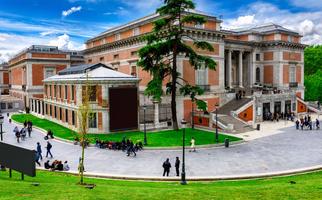
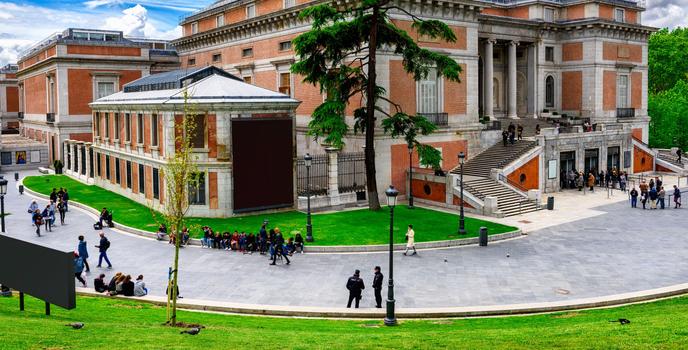
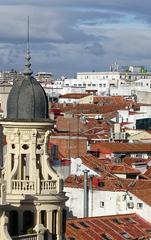
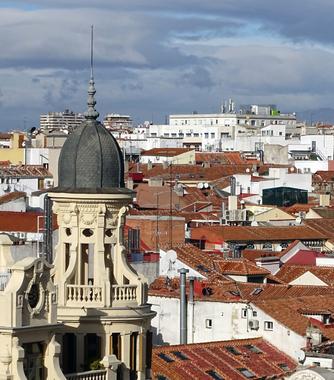
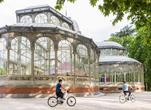
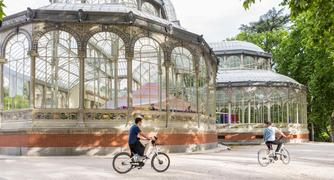
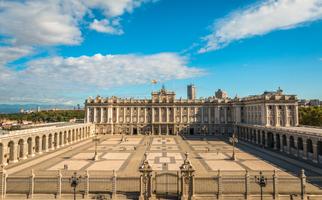
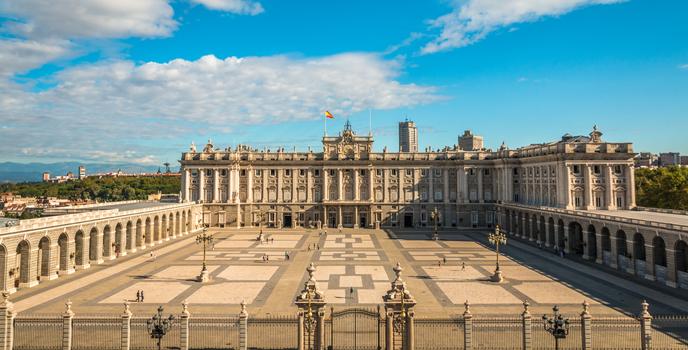
1. Paseo del Prado: Golden Triangle of Art
Spain's Capital city is renowned for its art, and the greatest masterpieces live on Paseo del Prado. The Prado Museum boasts the epic classical works of Goya, Valazquez and Bosch, among others. A short walk along the avenue, past the botanical gardens, lies the Reina Sofía, famous for Picasso’s Guernica, regarded as the most powerful anti-war painting ever produced. For dedicated art lovers, the Thyssen Museum's collections complete this golden triangle for the Ages.
2. Chueca: The Heartbeat of Madrid
The street that never sleeps, the Gran Via, directs the pulsating energy of the city straight into the Chueca neighborhood. Whether it's for upscale shopping, gorging on the most spectacular tapas spreads, spending endless nights in clubs, or going back for more tapas, visitors won’t forget this lively part of their trip.
3. Parque del Retiro: A Pleasant Retreat Indeed
In Madrid's city center lies the expansive Buen Retiro Park, where locals and tourists alike can enjoy countless recreational activities, world-renowned botanical gardens and spectacular landscaping - including sculptural elements worthy of the Prado Museum itself. The centerpiece of the park is the Crystal Palace, an extraordinary feat of design. Need to take a break from the warm Spanish air? You can also rent a rowboat and drift across the shimmering Retiro pond.
4. Palacio Real de Madrid: Truly Royal
Madrid's largest and most spectacular architectural wonder is the Royal Palace, or "Palacio Real." Also the largest in all of Western Europe, this Palace transports visitors to a an extravagant place, boasting more artwork by great Masters - the likes of Velazquez and Caravaggio - than many European museums, and displaying a life of royal splendour with untouched accuracy.
5. Mercado de San Miguel: Come Hungry
Nearby the Plaza Mayor, San Miguel is a foodie’s heaven. In this gourmet tapas market visitors can sample the culinary delights of countless vendors specializing in modern variations of traditional Spanish dishes. The market’s beautifully intricate wrought iron building, erected in 1916, is worth a visit in itself.








Where to Eat in Madrid
Madrid is a wonderful gastronomic destination, so diners are spoiled for choice. If you want great tapas, try restaurants on Calle Bava Baja like Casa Lucas. There are Andalucian delights available at Sanlucar, gourmet creations from Catalan chef Ramón Freixa at the Hotel Único, and succulent roast meat dishes at Botin, which claims to be the world's oldest restaurant. Prices vary depending on where you eat, but you can dine very well for under EUR25.
When to visit Madrid
Weather-wise, Madrid starts heating up around April and stays warm (and often scorching hot) until October. The best sightseeing conditions are in May and early June or September. However, even high summer is pleasant in Madrid as humidity levels tend to be low. Then again, the summer crowds make spring or fall an ideal time to visit.
How to Get to Madrid
Plane
Madrid Barajas Airport (MAD) has direct connections with North American cities like Philadelphia, Dallas, and New York, and is located around eight miles northeast of the city center. To reach downtown Madrid, you can take an express bus that costs EUR5, the Cercanías suburban train system (EUR2.60), or the subway, which costs EUR5 - take the pink line (number 8). An even cheaper (but less reliable) option is to take bus number 200, which costs just EUR1.50.
Train
Madrid's Atocha and Chamartin stations are linked to most major western European cities by Spain's Renfe train network, which provides an efficient and comfortable service. If you are coming from Paris or Barcelona, it's an excellent way to travel. Both stations are on the subway network, so it will cost you EUR1.50 (a single fare) to get into the center of town.
Car
If you are driving from France, the fastest route is to take the E-15 to Barcelona, then the E-90 to Madrid, although there is also a northern route via Bilbao that involves taking the E-80 then the E-5. From Lisbon, take the A6, then the E802 and finally the E-90 all the way to Madrid.
Bus
Madrid has plenty of bus connections to the rest of Spain and Europe, with companies serving the city including Alsa, Eurolines, and Avanza. Most long-distance buses will terminate at the Avenida de América bus station, which is also on the Metro, about 10 minutes' journey from the center of the city.
Airports near Madrid
Airlines serving Madrid
Where to stay in Madrid
Gran Via - the most upmarket part of the city, Gran Via is awash with enticing designer stores and gourmet restaurants. Staying here puts you within a few minutes' walk of the Prado and the Royal Palace, as well as San Miguel Market, the premier place to find fine food and fresh produce.
Popular Neighborhoods in Madrid
La Latina - more down to earth and bohemian in nature, La Latina is the city's oldest neighborhood. It's also the place to go for a tapas crawl, with the Calle Cava Baja packed with traditional and experimental bars. Then there's el Rastro, Madrid's vibrant flea market, the best place to find unique souvenirs.
Chueca - Madrid's center for gay clubbing is one of its more relaxed neighborhoods. If you love design and galleries, you won't want to miss creative hotspots like Mad is Mad, while anyone with a taste for Spanish wine will want to stock up at Vinoteca Vides.
Where to stay in popular areas of Madrid
Most booked hotels in Madrid
How to Get Around Madrid
Public Transportation
One of the best things about Madrid is how easy it is to get around by public transportation. Buses, trams, and Metro services all take the same tickets and cost the same amount (EUR1.50 per journey) and the subway has incredible reach. Day passes cost EUR8, while weekly passes come to EUR33.40, with big savings for children under 11 years of age.
Taxi
While public transportation is exceptional, Madrid's Metro shuts down at 1:30 am, so if you are heading home from clubbing, a taxi may be essential. You'll need to hail taxis, and look out for white vehicles with a red stripe as these are the officially regulated ones. The basic tariff is EUR2.40 for the meter drop, then about EUR1.40 per mile, although prices are higher at night.
Car
Many people who visit Madrid choose to rent a car, which makes it easier to visit out-of-town attractions like the El Escorial Palace or sports events at suburban venues. Companies like Enterprise, Hertz, and Sixt are all represented and rates can be as little as EUR20 per day. However, if you do rent a vehicle, try to avoid driving into central Madrid if you can avoid it. Parking is tricky (and expensive) and there's always the possibility that your vehicle will become trapped by other parked cars. Using the Metro is a better option to get into town.
The Cost of Living in Madrid
Shopping Streets
Madrid is a fantastic place for shoppers. If you are looking for upscale apparel stores, check out the streets around Gran Via. The Calle de Preciados is probably the busiest street, hosting stores like H&M, Pimkie, and Zara. The Calle Serrano in Salamanca is more upmarket still, with Gucci and Hermes stores (among many others).
Groceries and Other
Finding places to buy groceries in Madrid is never a problem. Aside from large food markets like the San Miguel Market, you'll find supermarkets like Carrefour, Dia, and Mercadona in most neighborhoods. Prices generally aren't high. Expect to pay about EUR3 for a gallon of milk or EUR1.60 for 12 eggs.
